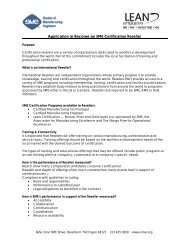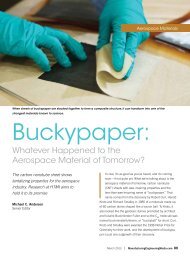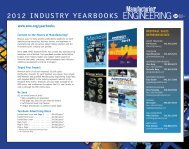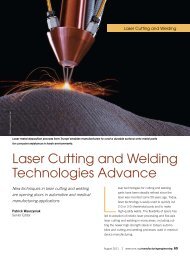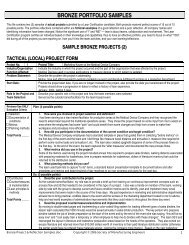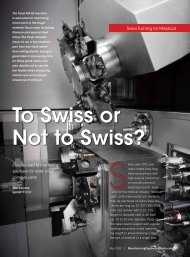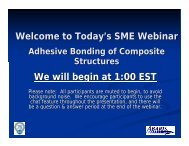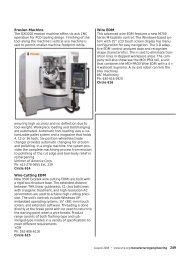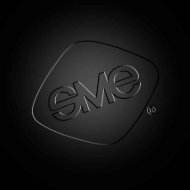Five-Axis Machines Offer Attractive Processing Choices - Society of ...
Five-Axis Machines Offer Attractive Processing Choices - Society of ...
Five-Axis Machines Offer Attractive Processing Choices - Society of ...
You also want an ePaper? Increase the reach of your titles
YUMPU automatically turns print PDFs into web optimized ePapers that Google loves.
<strong>Five</strong>-<strong>Axis</strong> Machining<br />
Mitsui Seiki’s Vertex 550-5XB is designed to machine<br />
aerospace or power generation turbine blades from<br />
forgings, castings, bar stock, or solid billets.<br />
<strong>Five</strong>-<strong>Axis</strong> <strong>Machines</strong> <strong>Offer</strong><br />
<strong>Attractive</strong> <strong>Processing</strong> <strong>Choices</strong><br />
Technology chases complex parts<br />
machining in a variety <strong>of</strong> industries<br />
Jim Lorincz<br />
Senior Editor<br />
The growing popularity <strong>of</strong> five-axis machining<br />
shouldn’t be a surprise. Manufacturers are becoming<br />
increasingly aware <strong>of</strong> the advantages <strong>of</strong><br />
3+2 positional or simultaneous five-axis machining<br />
<strong>of</strong> complex small and large parts. They have<br />
a wider selection <strong>of</strong> advanced machine platforms<br />
to choose from evidenced by the <strong>of</strong>ferings <strong>of</strong> machine tool<br />
builders and distributors at IMTS. <strong>Five</strong>-axis machining<br />
capability goes right to the heart <strong>of</strong> how parts as diverse as<br />
aerospace parts and a host <strong>of</strong> medical, and energy oil/gas<br />
parts can be efficiently processed with the highest accuracy<br />
and superior surface finishes. Parts designers can incorporate<br />
more features and functionality into parts working in<br />
October 2012 | ManufacturingEngineeringMedia.com 77
<strong>Five</strong>-<strong>Axis</strong> Machining<br />
materials ranging from titanium, Inconel, stainless steel to<br />
superalloys, as well as hardened steel and aluminum.<br />
<strong>Five</strong>-axis machining in both vertical and horizontal machines<br />
continues to add a dimension to process engineering<br />
that complements mill/turn and multitasking technology. In<br />
addition to better geometric accuracy and complete to near<br />
complete processing in minimum setups, five-axis machining<br />
<strong>of</strong>fers simplified workholding compared with traditional<br />
four-axis horizontal machining centers, and is capable <strong>of</strong> more<br />
aggressive roughing cuts. In addition, five-axis machines lend<br />
themselves to being readily handled in robotic, multiple pallet,<br />
and cellular configurations. Here’s a selection <strong>of</strong> recent fiveaxis<br />
machining developments:<br />
Mitsui Seiki USA Inc. (Franklin Lakes, NJ) has developed<br />
the Vertex 550-5XB five-axis CNC vertical machining center<br />
specially designed for the production <strong>of</strong> aerospace and power<br />
generation turbine blades from forgings, castings, bar stock,<br />
or solid billets <strong>of</strong> titanium, and stainless steel. Introduced at<br />
IMTS 2012, the machine meets design criteria suggested<br />
by manufacturers that include the ability to rough and finish<br />
parts in competitive cycle times with improved part accuracy<br />
and surface finish. According to Tom Dolan, Mitsui Seiki vice<br />
president, that adds up to “a total machining center package<br />
that had to be smaller, faster, more accurate than what they<br />
had been using—all at an affordable price.”<br />
“We’re seeing companies that have never<br />
been five-axis customers taking<br />
advantage <strong>of</strong> being able to buy <strong>of</strong>f-the-shelf<br />
equipment for these large workpieces.”<br />
Specification highlights <strong>of</strong> the Vertex 550-5XB include<br />
an X-Y-Z working envelope <strong>of</strong> 550 × 600 × 500 mm, rapid<br />
traverse rates in all linear axes <strong>of</strong> 48 m/min in a 65 ft² (6-m²)<br />
footprint. A and B axes are in a rotating/tilting table; A axis<br />
78 ManufacturingEngineeringMedia.com | October 2012
<strong>Five</strong>-<strong>Axis</strong> Machining<br />
tilts from +45 to −90° angles and the B axis features infinite<br />
positioning points. According to Dolan, a new non-traditional<br />
approach to engineering the rotary axes enhances manual<br />
and automatic load/unload operations, such as the integration<br />
<strong>of</strong> a robot and cellular manufacturing capability. The Vertex<br />
spindle is designed for cutting hard titanium and stainless<br />
steel under control <strong>of</strong> the latest Fanuc CNC. The Vertex<br />
550-5XB features a cast bed and a “box in a box” design for<br />
rigidity and stiffness that typically isn’t available in a machine<br />
<strong>of</strong> this size. All guideway mounting surfaces are hand-scraped<br />
after machining and grinding in Mitsui Seiki’s temperaturecontrolled<br />
factory.<br />
<strong>Five</strong>-<strong>Axis</strong> Can Take Heavy Cuts<br />
Kyle Klaver, five-axis product specialist at Okuma America<br />
(Charlotte, NC), says that as engineers put more features<br />
and functionality into larger parts, it’s increasingly difficult to<br />
machine these components using standard three-axis or even<br />
four-axis horizontal machining centers. “Mill/turns with a B axis<br />
like our Multus or MacTurns are great alternatives, but sometimes<br />
there is a greater need for milling and that’s where the<br />
five-axis machining center still has its strengths. It takes heavier<br />
cuts,” says Klaver. At IMTS, the MU-10000H, the largest <strong>of</strong><br />
the Okuma MU range <strong>of</strong> five-axis high-speed HMCs, made its<br />
world debut. The machine features a 1-m square pallet that<br />
can handle a 1.5-m diameter by 44" (1.1-m) high workpiece,<br />
weighing 5500 lb (2495 kg).<br />
“The MU-10000H is a new design <strong>of</strong> a horizontal<br />
machine for applications like large aerospace, energy, and<br />
heavy equipment applications,” says Klaver. “We’re seeing<br />
companies that have never been five-axis customers taking<br />
advantage <strong>of</strong> being able to buy <strong>of</strong>f-the-shelf equipment for<br />
these large workpieces, as well as other applications. The<br />
initial <strong>of</strong>fering is intended for titanium, Inconel, 15-5 stainless,<br />
and high-temperature heat-resistant alloys, and it can<br />
cut aluminum as well.” Two spindles, one with standard<br />
torque and a high-torque version, are available depending<br />
on customer requirements, and the machine is equipped<br />
with a two-pallet changer.<br />
”Aircraft parts have very elongated aspect<br />
ratios like a rib and require a huge amount<br />
<strong>of</strong> X axis relative to Y and Z axes.”<br />
Also introduced to the US at IMTS, Okuma's VTM-1200YB<br />
vertical turning CNC lathe has simultaneous five-axis machining<br />
capability. “It’s a 1.2-m chuck machine VTL with a<br />
B-axis head with a Y axis that is able to process parts on this<br />
machine in two operations,” Klaver explains. “Typical parts<br />
include large cylindrical housings that require a lot <strong>of</strong> milling<br />
and a lot <strong>of</strong> angled holes and features. It changes the way you<br />
process parts. You’re no longer thinking that you have to run<br />
parts on a large lathe and then take it over to the mill and set<br />
it up two times. Now you can do a turning operation, flip the<br />
part over and then finish it.”<br />
Structural Parts Get New Fixturing Process<br />
DMG / Mori Seiki (H<strong>of</strong>fman Estates, IL) has devised what<br />
it calls “pinch fixturing” to virtually eliminate deflection in<br />
five-axis milling <strong>of</strong> asymmetric structural parts on a mill/turn<br />
machine. “Basically, we’re doing five-axis machining with a<br />
nine-axis machine and drawing some dramatic benefits doing<br />
it,” explains Greg Hyatt, chief technology <strong>of</strong>ficer. “It’s an all<br />
80 ManufacturingEngineeringMedia.com | October 2012
milling application, and no turning is involved.<br />
By using the mill/turn and putting<br />
robotic clamping units on the lower<br />
turrets, we run the lower turret up and<br />
clamp on the workpiece, where we want<br />
to, when we want to. As we move from<br />
pocket to pocket in typical structural<br />
parts, we’re completely unconstrained<br />
by any traditional fixture.”<br />
At IMTS, DMG / Mori Seiki demonstrated<br />
the pinch-fixturing technique on<br />
an NT 4300 machining a large workpiece<br />
that resembled a wing rib from<br />
a Boeing 737. “Because we’re putting<br />
this solution on a mill/turn machine, we<br />
can handle a structural part 6-m long on<br />
an NT 6600, for example,” says Hyatt.<br />
“That’s part <strong>of</strong> the beauty <strong>of</strong> this system.<br />
Aircraft parts have very elongated aspect<br />
ratios like a rib and require a huge<br />
amount <strong>of</strong> X axis relative to Y and Z axes.<br />
The mill turning envelope is well suited<br />
to typical aircraft structural parts like rib<br />
spars, stringers, segments, flap tracks,<br />
and landing gear components.”<br />
Hyatt credits the technique with overcoming<br />
the tendency <strong>of</strong> fixtured forgings<br />
that have residual stress to spring back<br />
after cutting and being unclamped,<br />
requiring multiple machining cuts to get<br />
an accurate part. “Using this method<br />
and having no fixture and avoiding the<br />
problem <strong>of</strong> overconstraining the part,<br />
we use the lower turret to support the<br />
part while we’re cutting the pocket. We<br />
can immediately release it and let the<br />
part spring, reclamp the part, semifinish<br />
or finish a pocket on the opposite side,<br />
release it, reclamp. We can consolidate<br />
multiple operations into a single operation,<br />
working all the way around the part<br />
and allowing us to relieve all <strong>of</strong> that<br />
residual stress without all the operator<br />
intervention <strong>of</strong> multiple refixturing and<br />
indicator checks,” Hyatt explains.<br />
October 2012 | ManufacturingEngineeringMedia.com 81
<strong>Five</strong>-<strong>Axis</strong> Machining<br />
Photo courtesy Mazak<br />
Don’t Want to Go<br />
Back After <strong>Five</strong>-<strong>Axis</strong><br />
AT IMTS, Methods<br />
Machine Tools Inc.<br />
(Sudbury, MA) introduced<br />
its new Matsuura<br />
MAM72-100H five-axis<br />
horizontal machining<br />
center with a large<br />
capacity work envelope<br />
<strong>of</strong>fering the ability to cut<br />
challenging materials in<br />
complex aerospace and<br />
energy industry parts.<br />
The MAM 100H can<br />
handle 360 tools on the<br />
machine, starts with two<br />
Small footprint VCN Compact is designed for five-axis machining <strong>of</strong> tough materials such as pallets and is expandable<br />
to a six-pallet<br />
stainless steel, Inconel and titanium.<br />
system or FMS. “We<br />
are noted for our multi-pallet systems, whether standalone or<br />
in an FMS environment,” explains Michael Minton, Methods<br />
Machine national application engineering manager.<br />
“Once our customers move into five-axis machining,<br />
they rarely if ever go back, because workholding becomes<br />
so much simpler and cost effective. Rather than having<br />
eight parts on a horizontal tombstone, they’re machining<br />
one part just as fast as they did the eight parts, if not faster,<br />
with simpler workholding. Our engineers are raving about<br />
one product called the Raptor fixture with a simple dovetail<br />
design in a low pr<strong>of</strong>ile system. It allows you to get to five<br />
sides <strong>of</strong> the part with minimal fixturing interference on any<br />
five-axis platform,” says Minton.<br />
“The biggest advantage with five-axis machining is geometric<br />
accuracy, because you can get to five sides <strong>of</strong> that part<br />
in one setup,” according to Dave Lucius, Methods vice president-sales.<br />
These systems really shine when customers are<br />
being pushed for tighter and tighter tolerances. Applications<br />
in aerospace, power generation, and for turbine applications<br />
include blades and blisks, and include blades and impellers<br />
in land-based diesel engines.”<br />
Having the ability to process workpieces vertically or<br />
horizontally on five-axis machines can yield important gains<br />
in accuracy. “Depending on how you process the part, you<br />
have the opportunity to put precision bores in vertically and<br />
82 ManufacturingEngineeringMedia.com | October 2012
do a lot <strong>of</strong> the milling horizontally, and you can flip around the<br />
processes to gain accuracy. When you bore vertically, you are<br />
more accurate than boring horizontally. You have flexibility by<br />
combining two types <strong>of</strong> machine geometries into one machining<br />
platform to further enhance your<br />
process and part geometric accuracy,”<br />
Lucius explains.<br />
Methods Machine Tools <strong>of</strong>fers its<br />
five-axis Matsuura machines with a<br />
CAMplete post processor s<strong>of</strong>tware<br />
which shows what the machine will do<br />
based on the program and will optimize<br />
the toolpath. “To take any mystery out <strong>of</strong><br />
five-axis machining we <strong>of</strong>fer a bimonthly,<br />
complimentary three day course to<br />
our customers. When customers come<br />
to our technology center, we can show<br />
them how easy five-axis machining<br />
is rather than spending time to try to<br />
familiarize themselves with the platform<br />
itself,” says Lucius. “We have great<br />
success in making people comfortable<br />
moving from a traditional vertical or a<br />
horizontal machining center into fiveaxis<br />
machining.”<br />
40-taper spindle, it is designed for five-axis machining <strong>of</strong> tough<br />
materials, such as stainless steel, Inconel, and titanium used<br />
in medical and other applications. The machine’s three linear<br />
axes reach high-speed rapid traverse rates <strong>of</strong> 1417 ipm (36<br />
Compact <strong>Five</strong>-<strong>Axis</strong><br />
Meets Precision Needs<br />
<strong>Five</strong>-axis machining is increasingly<br />
taken to the extremes in processing<br />
small parts in small footprint platforms<br />
for medical device manufacturing, and<br />
larger machines for aerospace applications,<br />
according to Marc Jagoda, applications<br />
manager, Mazak Corp. (Florence,<br />
KY). At IMTS, Mazak introduced<br />
its Vertical Center Nexus Compact,<br />
which is available in three and five-axis<br />
versions for medical applications and<br />
its Vertical Center Universal 400 fiveaxis<br />
machine.<br />
The VCN Compact features a 25-hp<br />
(18.6-kW), 12,000-rpm CAT 40 spindle<br />
and X-Y-Z axis travels <strong>of</strong> 19.69 × 16.93<br />
× 20" (500 × 430 × 510 mm). With its<br />
October 2012 | ManufacturingEngineeringMedia.com 83
<strong>Five</strong>-<strong>Axis</strong> Machining<br />
m/min) and fast feed rates <strong>of</strong> 315 ipm (8 m/min). <strong>Five</strong>-axis<br />
machining is rigid and precise on a rotary/tilt table constructed<br />
with high-speed roller drive technology, allowing the table to<br />
rotate and tilt at speeds <strong>of</strong> 100 rpm and 75 rpm, respectively.<br />
Mazak also demonstrated its VCU<br />
400-5X advanced technology for machining<br />
high-precision small-parts for<br />
various industries, including medical,<br />
aerospace, electronics, and automotive.<br />
Based on a modular design platform,<br />
the machine is easily configured as a<br />
three-axis fixed table or five-axis rotary/<br />
tilt table model. Both machines share<br />
the same small footprint and table size<br />
<strong>of</strong> 15.7 × 15.7" (399 × 399 mm), allowing<br />
them to fit into almost any manufacturing<br />
facility. Each machine’s linear<br />
X-Y-Z-axis travels measure 19.6 × 15.7<br />
× 20" (498 × 399 × 508 mm) and attain<br />
rapid traverse rates <strong>of</strong> 945 ipm (24 m/<br />
min). Both models are equipped with<br />
10,000-rpm, 15-hp (11-kW), 40-taper<br />
spindle for machining materials, including<br />
steel, aluminum, and cast iron.<br />
at its Hawthorne, CA, plant. The two high-speed PMT gantries<br />
will be used to produce aluminum wide-body fuselage skins<br />
for next-generation commercial aircraft. The modular PMT is<br />
a five-axis gantry machine tool for high-speed multiprocessing<br />
“Once our customers<br />
move into five-axis<br />
machining, they rarely<br />
if ever go back,<br />
because workholding<br />
becomes so<br />
much simpler and<br />
more cost effective.”<br />
High-Speed Gantry For<br />
Aerospace Materials<br />
For machining large composite or<br />
nonferrous aerospace parts, Triumph<br />
Aerostructures Vought Commercial Division<br />
has ordered two MAG Precision<br />
Mill/Trim (PMT) gantry systems for installation<br />
in 2013 on existing X-axis rails<br />
October 2012 | ManufacturingEngineeringMedia.com 85
<strong>Five</strong>-<strong>Axis</strong> Machining<br />
<strong>of</strong> large nonferrous components, such composite structures,<br />
aluminum skins and fabrications, molds, patterns, and postcure<br />
cutouts in foam and sandwich structures. In addition to<br />
machining, the highly configurable PMT is designed to use<br />
various special heads, such as waterjet, sawing and other<br />
finishing tools, including a system for precision control <strong>of</strong><br />
countersink depth.<br />
The machine’s unlimited X axis is accompanied by its<br />
configurable Y axis <strong>of</strong> 2–6 m; Z axis <strong>of</strong> 1, 1.5 or 2 m; feed<br />
rates up to 60 m/min; five-sided part access; and optional<br />
precision scale feedback. The compact dual-axis rotary<br />
spindle head is powered by direct-drive torque motors with<br />
encoder feedback, providing 220° <strong>of</strong> A-axis tilt and standard<br />
550° <strong>of</strong> C-axis rotation. The PMT’s rail-type configuration<br />
allows a variety <strong>of</strong> workholding systems to be adapted,<br />
including MAG’s Flexitool universal workholding system. The<br />
Flexitool system consists <strong>of</strong> modular table sections equipped<br />
with programmable vertical actuators tipped with swiveling<br />
vacuum end effectors that adjust to almost any part shape,<br />
MAG’s five-axis Precision Mill-and-Trim gantry features an<br />
unlimited X axis for machining large composite or nonferrous<br />
parts, especially for the aerospace industry.<br />
so nests <strong>of</strong> various part shapes can be machined in multiple<br />
workzones. <strong>Five</strong> different motorized spindles are available<br />
beginning with a standard 22,000 rpm/20 kW and ranging<br />
up to 30,000 rpm/42 kW. ME<br />
Want More Information<br />
DMG / Mori Seiki<br />
Ph: 847-593-5400<br />
Web Site: www.dmgmoriseikiusa.com<br />
MAG IAS<br />
Ph: 859-534-4600<br />
Web Site: www.mag-ias.com<br />
Mazak Corp.<br />
Ph: 859-342-1700<br />
Web Site: www.mazakusa.com<br />
Methods Machine Tools Inc.<br />
Ph: 978-443-5388<br />
Web Site: www.methodsmachine.com<br />
Mitsui Seiki USA Inc.<br />
Ph: 201-337-1300<br />
Web Site: www.mitsuiseiki.com<br />
Okuma America Corp.<br />
Ph: 704-588-7000<br />
Web Site: www.okuma.com<br />
86 ManufacturingEngineeringMedia.com | October 2012





